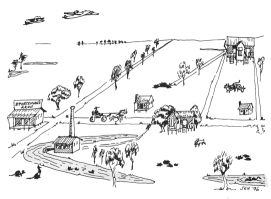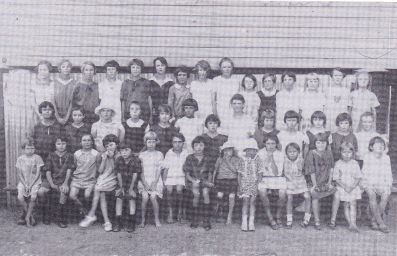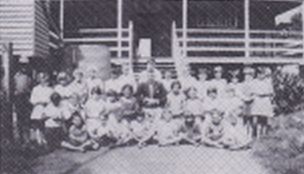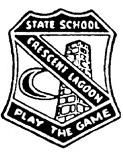The history of the Crescent Lagoon State School as told on our website, has been divided into three sections; its initial early establishment on Nine Mile Road, the move from this modest floodprone location, and finally North Street Extended where the school is still located today.
A public meeting was held at the Sportsman's Arms Hotel on December 11th, 1894. The purpose was to form a committee to promote the establishment of a state school at Crescent Lagoon.
The main reason for seeking the establishment of the new school was due to the difficult distance, an ever growing number of young children were required to travel in order to attend the closest school situated at Allenstown. To reach the Allenstown School, children were required to cross the Athelstane Range, a difficult journey in hot weather, and for some children, the daily journey meant travelling as far as 6km each way. Two or three court cases also arose, concerning attacks on young girls on their way to the town school, further highlighting the need for a closer 'local' school.
Mr Canny, the District Inspector of Schools concluded in his report into the need for a new school, that due to these reasons and also the overcrowding taking place at Allenstown State School, a new school at Crescent Lagoon should be constructed to relieve the situation. It was decided that the new school would cater for between eighty to one hundred students.
A piece of land, one acre in size was procured as a site, but Mr Canny thought this to be too small. The Hon. John Ferguson MLC, donated two acres of land fronting on Nine Mile Road. The owner of the local brickworks, Mr I Roderkirchen, pledged to donate the bricks required for the erection of piers to support the school building. So at the time of Mr Canny's inquiry, £75 - seventy-five pounds ($150.00) of the target public contribution total of £160 - one hundred and sixty pounds (up to $320) required to build the school had been achieved.

With the financial matters settled, construction of the new school began. The site, flat, high and well drained, was cleared of all unnecessary timber. By 1896, the school building and residence were nearly completed and all that remained was for the fences to be replaced urgently so that the school would be ready to open after the winter vacation of that year. On July 1st, 1896 George Alfred Carey was appointed to the position of the first head teacher of Crescent Lagoon. The school officially open on July 8th, 1896.
By 1900, the then committee was again engaged in raising funds to allow for the enlargement of the school building. The original building was designed to accommodate eighty pupils, yet by July 1900, the average attendance was 108, and the number of pupils enrolled was 142.
In 1918, the year of the Great Flood, during January and February, more than 700 people in the Rockhampton district were forced from their homes, and school work had to be suspended for several days. Residents and pupils had to traverse swampy ground, and the flood waters rose halfway up the walls of the Head Teacher's Residence.
Further flooding occurred in 1928 leading to calls for the relocation of the school to higher ground. The favoured site was a block fronting on to North Street Extended. This land was more centrally situated and located at least 10 feet above the flood level of 1918. In May 1929, the District Inspector of Schools, W. J. Trudgian visited the proposed site with members of the Parents Association. In his report, he strongly recommended the site both on the score of centrality and suitability. On the 6th September 1929, this 4 acre site was purchased from Mr James Hoye for the sum of £200 - two hundred pounds ($400).

However the transition was not smooth, as these were the years of the Depression and funds were not readily available. The Parents Committee wanted the land to be fenced so that they could begin planting trees in the grounds and transplanting prize specimens such as the rose bushes from the old site.
Government departments - Education and Works, were seeking the most economical way of making the shift. One plan was that the school and residence, both in need of repair, be moved directly. Another was that the residence be offered for sale for £400 - four hundred pounds ($800), but if this price was not obtained that the building be transferred to the new site. A wing from the Mt Morgan Girls School could also be shifted to the North Street Extended site. This would enable school work to continue at the old school without interruption until the other building was ready. After the transfer, the old Crescent Lagoon School could then be shifted to Berserker Street or Yeppoon - both schools in need of extra accommodation.

The latter proposal was accepted. A wing from the Girls School at Mt Morgan was shifted to the new site of the Crescent Lagoon State School and the Head Teacher's residence was moved up from its original site too. The necessary instructions were issued in April 1932.

Government departments - Education and Works, were seeking the most economical way of making the shift. One plan was that the school and residence, both in need of repair, be moved directly. Another was that the residence be offered for sale for £400 - four hundred pounds ($800), but if this price was not obtained that the building be transferred to the new site. A wing from the Mt Morgan Girls School could also be shifted to the North Street Extended site. This would enable school work to continue at the old school without interruption until the other building was ready. After the transfer, the old Crescent Lagoon School could then be shifted to Berserker Street or Yeppoon - both schools in need of extra accommodation.
Delays occurred, due to arguing between the council and State Government departments as to who was responsible for the additional setup costs, such as water connection and fencing. Eventually these problems were resolved and Mr A.W.L. Russell, the Head Teacher, resumed his duties early October 1932. Water was connected on November 8th. Mr Russell requested that the infant room of the old school be removed and moved to the new site for future growth but due to a decline in the average attendances to about 86.5 out of an enrolment of 96, his request was declined.
Further setbacks and delays occurred. The school had to be closed briefly on October 31st, 1932, when the head teacher sent the entire student body home, due to the workmen failing to have the school furniture moved to the new location, and finish the toilets. The school did eventually re-open on the following day, November 1st, even though the workmen were still finishing tasks around the school yard.
Arrangements were made for the sale and removal of the remaining old school buildings from the original site. An interesting fact concerning the move was some of the books and records etc, which were transferred from the old school to the new, were carried in billy-carts driven by the pupils.
During the fifty years that followed the establishment of the school, the student population remained fairly stable. The numbers fluctuated around the total of 100 while average attendances were consistently high. There was a peak of 142 in 1900, but in 1932 when the school was relocated, the numbers enrolled totalled 96.
The late forties and fifties saw steady increases in the student numbers. The West Rockhampton district was developing quickly. The Queensland Housing Commission was siting a number of homes in the area. Married quarters for military personnel were located in West Rockhampton, close to the base in Western Street. By 1953, the number of enrolments had more than doubled to 186 and by 1972 had reached 435.
Growth on this scale brought problems. Letter after letter was sent to the department, requesting more classrooms to accommodate the increasing numbers.
New classrooms were built and the school grew piecemeal. But this growth involved more that just new classrooms. The rooms had to be staffed and provided with furniture. Sanitary facilities had to be enlarged. The conveniences designed to serve 70 children were now being used by 200 children. In 1962, approval was given for the provision of new toilet blocks connected to the Town Sewerage Scheme. Happily this was given urgent priority and work was started almost immediately. It wasn't until 1993 that concrete paths which allowed all weather access to the toilet blocks were laid.
Later extensions to the toilet blocks and additional classrooms encroached on the available playing spaces. A greater number of children were now using an area less than that available to those attending school 20 years earlier. By 1972, enrolment was 470 and the entire school reserve was only a little more than four acres. The construction of the swimming pool in 1971 had further reduced the available playing space. To help relieve this problem, five houses and properties facing onto Willis Street, were purchased adding valuable space to the school reserve.
Cresso the Croc
Cresso the Croc is the mascot of the Crescent Lagoon State School. He was adopted as the school mascot in late 1979 when the first Cresso Awards were presented.
Mr Martin Linnane proposed the idea of the awards after he returned to Crescent Lagoon after a year of teaching in Canada. They were to recognise effort and improvement, or commendable personality traits or social behaviour. Children who possibly had little chance of shining in the academic work of the classroom or of gaining a sporting trophy were rewarded for trying hard or for overcoming a handicap. Cheerfulness, co-operative nature and consideration of others were all desirable qualities.
A sporting hero who struggled in the classroom could be rewarded for trying to improve handwriting and neatness. An academic star who was a sporting 'try-er' could be given an award for giving it their best.
Cresso, since this humble beginning, has grown in statue and been adapted to bookplates on exercise books and into a number of other incarnations.
The Cresso Awards are also used as 'Thank You' presentations for distinguished visitors and other persons from outside the school community who have proven helpful and supportive.

School Song
Daily we come to our school by the hill,
Ready to try hard and work with a will.
Set to take our part at work and at play
Improving every way we can, day by day.
Chorus:
Crescent Lagoon is our school
And "Play the Game" is our motto and our rule.
Each generation does its very best
To make sure that "Cresso" stays better than the rest.
We try in the classroom and in the playground too,
Aiming for the best in everything we do.
We follow in the footsteps of those who led the way
To make our school the best in Queensland today.
The Badge
During the 1950's, the P & C designed and had produced a school badge. Of a simple shield design, the badge features the school's name and motto, "Play The Game". A blue crescent recalls Crescent Lagoon, while the chimney represents the waterworks, a feature of the landscape for many years.
